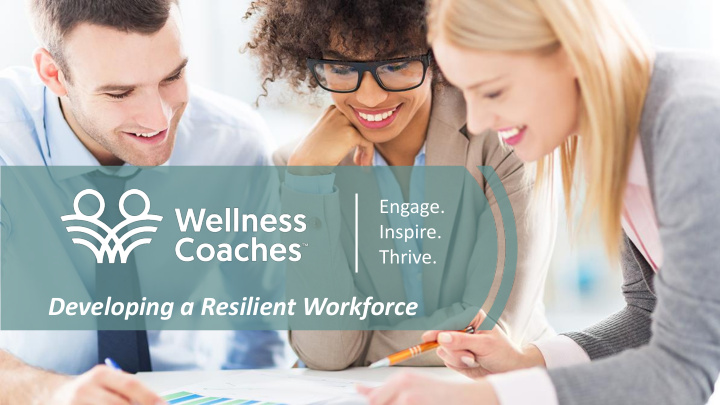



Engage. Inspire. Thrive. Developing a Resilient Workforce
Why Are We Here Today? • The Role of Resiliency in the Dynamic Workplace • Who We Are and How We Coach • The Link Between Reskilling and Resiliency • Helping Employees Become More Resilient • Your Next Steps
Meg Spencer: Director of Training and Development • EDIT Bachelor of Arts with a double major in Exercise and Sport Science and Psychology, University of North Carolina at Chapel Hill • EDIT Certified Strength and Conditioning Specialist, National Strength and Conditioning Association • EDIT Joined Wellness Coaches in 2009 • EDIT Has served as Senior Wellness Coach, New Hire Trainer, Mentor Coach, and Coaching Team Lead
Amber Boyer: Client Service Support • Bachelor of Arts with a double major in Exercise and Sport Science and Psychology, University of North Carolina at Chapel Hill • Certified Strength and Conditioning Specialist, National Strength and Conditioning Association • Joined Wellness Coaches in 2009 • Has served as Senior Wellness Coach, New Hire Trainer, Mentor Coach, and Coaching Team Lead
A Dynamic Workplace The average worker currently holds 10 different jobs before age 40 , and this number is projected to grow. It is predicted that today's youngest will hold 12 to 15 jobs in their lifetime . Source: Bureau of Labor Statistics and Forrester Research
A Dynamic Workplace Emerging technologies and related factors are expected to disrupt 1.4 million jobs in the U.S. between now and 2026 Source: National Center for Health Statistics
A Dynamic Workplace Source: Future of Jobs Report, World Economic Forum 2016
Who is Wellness Coaches? Our Mission is to harness the power of coaching to inspire and move entire populations to improved health, safety and quality of life.
Who is Wellness Coaches? • Founded in 2002 • Largest onsite coaching provider • Operating in 35 States • Over 500 Client Locations • All Sizes / All Trade Channels • ≈ 200 On-Site Coaches and Registered Dietitians
What We Believe Everyone wants to be healthy and safe, but it’s not easy to accomplish on your own. Employees will need live, one-on-one personal support to live their healthiest, safest lives. Engaging with an onsite coach, in the workplace, is the best way to achieve and sustain healthy behavior change.
Our Coaches Have at least a 4 year Bachelor’s Degree 70% have a Masters Degree or Advanced License Bi-lingual when required Average of 9 years experience and proven success in one or more of the following: • Corporate Wellness • Exercise Physiology/Science • Health Promotion • Occupational Therapy • Certified Athletic • Strength and Conditioning Training • Registered Dietitian • Sports Medicine
Inspiring and Engaging to Create a Culture of Health and Wellbeing Behavior Change Science and Evidence Based Practices Proactive Engagement > 86% Coach to all Stages of Change Client-Centered Approach
Reskilling and Resiliency How can you help employees move beyond “dealing with the stress” of disruptive change to “becoming resilient” in the face of disruptive change?
Reskilling and Resiliency “Resilience is the ability to recover well from setbacks, adapt well to change, and keep going in the face of adversity.” – Harvard Business Review
Reskilling and Resiliency Lift – Reskill to Increase Competence for Shift – Resiliency to Elevate Confidence to Change Change • Incentivize training and skill • Mindfulness and awareness of development throughout work life emotions/emotional intelligence • Innovate learning to fit how, where and • Becoming curious and broadening when employees want to learn perspective to think more positively • Integrate technology into every learning • Committing to healthier lifestyle habits event – all companies will be digital to promote increased personal energy for greater resiliency • Focus more on work experiences and less on functional titles
Emotional Intelligence and Mindfulness Emotional Intelligence Perceive Emotions Developing self-awareness to know what you are feeling and why Developing self-management to handle Emotional Use Understand disruptive emotions Emotions Intelligence Emotions How? Mindfulness Manage Emotions
Personal Exploration Positive Mindfulness Outlook Energy
Maximizing Personal Energy NUTRITION PHYSICAL ACTIVITY SLEEP STRESS HEALTHY MIND & FEELINGS EMPOWERMENT & PLANNING
Building Resiliency – Make the Shift • Practice everyday mindfulness • Explore deep breathing and meditation techniques • Commit to healthier habits • Practice gratitude and self-compassion
Your Next Steps • Develop open and engaging feedback channels to stay connected to the evolving needs of employees. • Develop a vision of what resiliency means to your organization and your employees. • Reevaluate wellness programs in the context of resiliency and disruptive change. • Pay attention to wellness programs to ensure that you are addressing the individual’s fears and aspirations as the workplace continues to be disrupted,
Recommend
More recommend